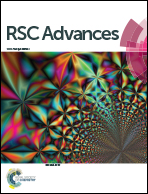Solvent assisted size effect on AuNPs and significant inhibition on K562 cells†
Abstract
Herein, the synthesis and characterization of ideal size (∼10 and 40 nm, in diameter) AuNPs (gold nanoparticles) were reported. Two different organic solvents such as DMF (dimethyl formamide) and NMPL (N-methyl-2-pyrrolidone) were used to synthesize AuNPs along with agents reducing agents such as NaBH4 (sodium borohydrate) and Na3C6H5O7 (sodium citrate). The combination of [(HAuCl4)–(DMF)–(NaBH4)] gives AuNPs with an avg. size of 10.2 nm. Similarly, the combination of [(HAuCl4)–(NMPL)–(Na3C6H5O7)] gives AuNPs with an avg. size of 40.4 nm. The morphology of these nanoscale AuNPs has been characterized through TEM and HRTEM imaging followed by SAED for lattice parameters such as d-spacing value (2.6 Å/0.26 nm) of crystalline metal (Au) nanoparticles. Further, these unique and ideal nanoscale AuNPs were used to evaluate the potential working efficacy by using in vitro cell based studies on K562 (leukaemia) blood cancer cells. From the MTT assay results around 88% cell inhibition was measured for ∼10 nm sized AuNPs. The treated cells were stained with different fluorescent dyes such as FITC, DAPI, Rho-6G and their ruptured morphology has been reported in the respective sections. These types of ideal sized metal (Au) nanoparticles are recommended for various theranostics such as to cure breast, colon, lung and liver cancers.



 Please wait while we load your content...
Please wait while we load your content...